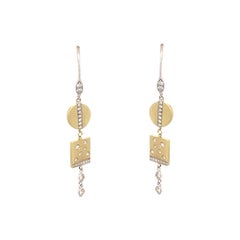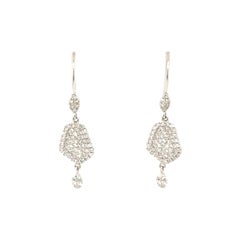Meira T On Sale
Recent Sales
21st Century and Contemporary Artisan Dangle Earrings
Diamond, 14k Gold, White Gold, Yellow Gold
21st Century and Contemporary Artisan Drop Earrings
Diamond, 14k Gold, White Gold
2010s Unknown Dangle Earrings
Diamond, White Diamond, Blue Sapphire, 14k Gold, White Gold
2010s Unknown Dangle Earrings
Diamond, White Diamond, Ruby, 14k Gold, White Gold
2010s Unknown Dangle Earrings
Diamond, White Diamond, 14k Gold, White Gold
21st Century and Contemporary More Necklaces
Diamond, White Diamond, Blue Sapphire, 14k Gold, White Gold
The Legacy of Diamond in Jewelry Design
Antique diamond rings, diamond tiaras and dazzling vintage diamond earrings are on the wish lists of every lover of fine jewelry. And diamonds and diamond jewelry are primarily associated with storybook engagements and red-carpet grand entrances — indeed, this ultra-cherished gemstone has a dramatic history on its hands.
From “A Diamond Is Forever” to “Diamonds Are a Girl’s Best Friend,” pop culture has ingrained in our minds that diamonds are the most desired, the most lasting and the most valuable gemstone. But what makes the diamond so special? Each stone — whether it’s rubies, sapphires or another stone — is unique and important in its own right. April babies might claim diamonds for themselves, but just about everyone wants this kind of sparkle in their lives!
There are several factors that set diamonds apart from other stones, and these points are important to our gem education.
Diamonds are minerals. They are made up of almost entirely of carbon (carbon comprises 99.95 percent; the remainder consists of various trace elements). Diamonds are the hardest gemstones, ranking number 10 on the Mohs Hardness Scale. Even its name, diamond, is rooted in the Greek adamas, or unconquerable. The only object that can scratch a diamond is another diamond. Diamonds are formed deep within the earth at very high temperatures (1,652–2,372 degrees Fahrenheit at depths between 90 and 120 miles beneath the earth’s surface) and are carried up by volcanic activity. Diamonds are quite rare, according to the Gemological Institute of America, and only 30 percent of all the diamonds mined in the world are gem quality.
In the 1950s, the Gemological Institute of America developed the 4Cs grading system to classify diamonds: clarity, color, cut and carat weight. Not all diamonds are created equal (there are diamonds, and then there are diamonds). The value of the diamond depends on the clarity (flawless diamonds are very rare but a diamond's value decreases if there are many blemishes or inclusions), color (the less color the higher the grade), cut (how the diamond’s facets catch the light, certain cuts of diamonds show off the stone better than others) and carat weight (the bigger, the better).
When you start shopping for a diamond engagement ring, always prioritize the cut, which plays the largest role in the diamond's beauty (taking the time to clean your diamond ring at least every six months or so plays a role in maintaining said beauty). And on 1stDibs, a range of buying guides can be found for those in the market for antique engagement rings, vintage engagement rings or Art Deco engagement rings.
Shop antique and vintage diamond rings, diamond necklaces and other extraordinary diamond jewelry on 1stDibs.
Finding the Right Dangle-earrings for You
Earrings have a rich, diverse history, and while there are many types of this accessory to choose from, the dangle style is one of the most enduring designs. Today antique and vintage dangle earrings are timeless adornments that can make any outfit instantly more glamorous.
One of the oldest known pairs of dangle earrings was made of jade between 7,500 and 8,200 years ago in Inner Mongolia. Hoop earrings — of which there have been countless variations — are as old as Ancient Mesopotamia, and Ancient Egyptians wore dangle earrings that had sacred symbolism as part of their jewelry practices. In ancient Rome, dangle earrings with pearls and other precious materials were popular.
Dangle earrings vary in length, but they are all designed to cascade off the ears. Some dangle earrings barely fall past the bottom of the earlobe while others fall low enough to graze the shoulders or even fall past them. During the Renaissance period, women wore up-do hairstyles so they could show off their dangle earrings. Even noblemen joined the trend, donning a sole dangle earring adorned with a pearl.
Georgian women preferred heavy girandole earrings that featured candelabra-like arrangements of precious metal and stones. Dangle earrings in the 19th century were simpler, often featuring a single suspended gemstone in a drop-earring style. Going into the 20th century, screw-back earrings and clip-ons became popular, leading to more minimal stud designs. However, dangle earrings have always come back into fashion.
Whether they are made with diamonds, beads or feathers, dangle earrings are statement pieces reflecting the shifting styles over the years. Find the perfect antique and vintage dangle earrings for any occasion on 1stDibs.

